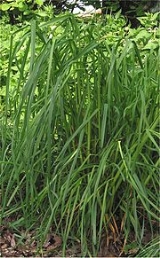
Dactylis
Encyclopedia
Dactylis is a genus of grasses
in the subfamily Pooideae
, native to Europe
, Asia
, and northern Africa
. They are known in English as cock's-foot or cocksfoot grasses, also sometimes as orchard grasses.
.
20–50 cm long and up to 1.5 cm broad, and distinctive tufted triangular flower
heads comprising a panicle
10–15 cm long, turning pale grey-brown at seed maturity. The spikelets are 5–9 mm long, typically containing two to five flowers. The stems have a flattened base, which distinguishes them from many other grasses.
. Dactylis glomerata subsp. glomerata and D. glomerata subsp. hispanica are tetraploid forms with 28 chromosomes. Several of the other taxa, including D. glomerata. subsp. himalayensis (syn. D. himalayensis), D. glomerata subsp. lobata (syn. D. polygama), D. metlesicsii, and some forms of D. smithii, are diploid with 2n = 14; hexaploids with 42 chromosomes also occur rarely.
Poaceae
The Poaceae is a large and nearly ubiquitous family of flowering plants. Members of this family are commonly called grasses, although the term "grass" is also applied to plants that are not in the Poaceae lineage, including the rushes and sedges...
in the subfamily Pooideae
Pooideae
The Pooideae is a subfamily of the true grass family Poaceae. It includes some major cereals such as wheat, barley, oat, rye and many lawn and pasture grasses.- List :...
, native to Europe
Europe
Europe is, by convention, one of the world's seven continents. Comprising the westernmost peninsula of Eurasia, Europe is generally 'divided' from Asia to its east by the watershed divides of the Ural and Caucasus Mountains, the Ural River, the Caspian and Black Seas, and the waterways connecting...
, Asia
Asia
Asia is the world's largest and most populous continent, located primarily in the eastern and northern hemispheres. It covers 8.7% of the Earth's total surface area and with approximately 3.879 billion people, it hosts 60% of the world's current human population...
, and northern Africa
Africa
Africa is the world's second largest and second most populous continent, after Asia. At about 30.2 million km² including adjacent islands, it covers 6% of the Earth's total surface area and 20.4% of the total land area...
. They are known in English as cock's-foot or cocksfoot grasses, also sometimes as orchard grasses.
Taxonomy
The genus has been treated as containing only a single species D. glomerata by many authors, treating variation in the genus at only subspecific rank within D. glomerata, but more recently, there has been a trend to accept two species, while some authors accept even more species in the genus, particularly island endemic species in MacaronesiaMacaronesia
Macaronesia is a modern collective name for several groups of islands in the North Atlantic Ocean near Europe and North Africa belonging to three countries: Portugal, Spain, and Cape Verde...
.
Description
Dactylis species are perennial grasses, forming dense tussocks growing to 15–140 centimetres tall, with leavesLeaf
A leaf is an organ of a vascular plant, as defined in botanical terms, and in particular in plant morphology. Foliage is a mass noun that refers to leaves as a feature of plants....
20–50 cm long and up to 1.5 cm broad, and distinctive tufted triangular flower
Flower
A flower, sometimes known as a bloom or blossom, is the reproductive structure found in flowering plants . The biological function of a flower is to effect reproduction, usually by providing a mechanism for the union of sperm with eggs...
heads comprising a panicle
Panicle
A panicle is a compound raceme, a loose, much-branched indeterminate inflorescence with pedicellate flowers attached along the secondary branches; in other words, a branched cluster of flowers in which the branches are racemes....
10–15 cm long, turning pale grey-brown at seed maturity. The spikelets are 5–9 mm long, typically containing two to five flowers. The stems have a flattened base, which distinguishes them from many other grasses.
Species
- Dactylis glomerataDactylis glomerataDactylis glomerata, Cock's-foot and orchard grass, is a common species of grass in the genus Dactylis, native throughout most of Europe, temperate Asia, and northern Africa.-Distribution:...
L. Throughout most of the range of the genus. - Dactylis marina Borrill. Western Mediterranean region (SW Europe, NW Africa).
- Dactylis metlesicsii Schönfelder & Ludwig. Canary IslandsCanary IslandsThe Canary Islands , also known as the Canaries , is a Spanish archipelago located just off the northwest coast of mainland Africa, 100 km west of the border between Morocco and the Western Sahara. The Canaries are a Spanish autonomous community and an outermost region of the European Union...
, endemic. - Dactylis smithii Link (syn. D. glomerata subsp. smithii (Link) Stebbins & Zohary). Canary Islands, Cape VerdeCape VerdeThe Republic of Cape Verde is an island country, spanning an archipelago of 10 islands located in the central Atlantic Ocean, 570 kilometres off the coast of Western Africa...
, MadeiraMadeiraMadeira is a Portuguese archipelago that lies between and , just under 400 km north of Tenerife, Canary Islands, in the north Atlantic Ocean and an outermost region of the European Union...
.
Cytology
The taxa show several different levels of polyploidyPolyploidy
Polyploid is a term used to describe cells and organisms containing more than two paired sets of chromosomes. Most eukaryotic species are diploid, meaning they have two sets of chromosomes — one set inherited from each parent. However polyploidy is found in some organisms and is especially common...
. Dactylis glomerata subsp. glomerata and D. glomerata subsp. hispanica are tetraploid forms with 28 chromosomes. Several of the other taxa, including D. glomerata. subsp. himalayensis (syn. D. himalayensis), D. glomerata subsp. lobata (syn. D. polygama), D. metlesicsii, and some forms of D. smithii, are diploid with 2n = 14; hexaploids with 42 chromosomes also occur rarely.

